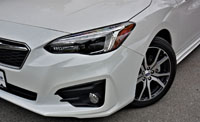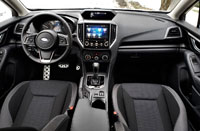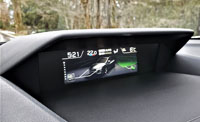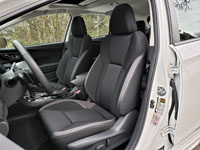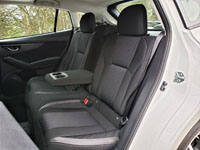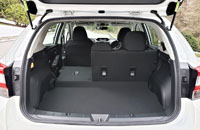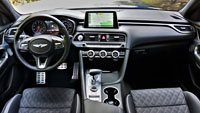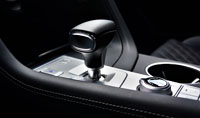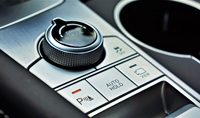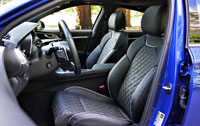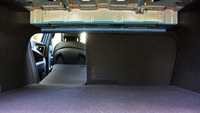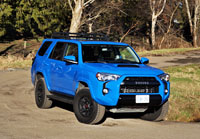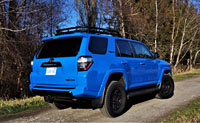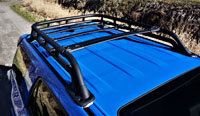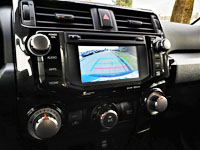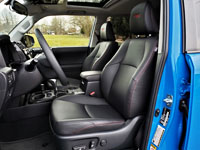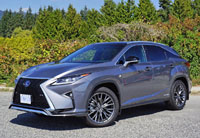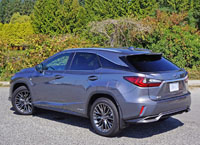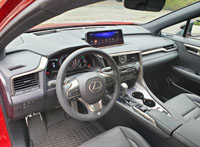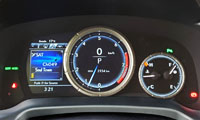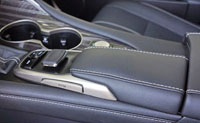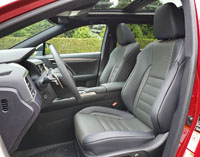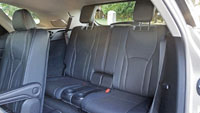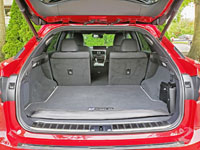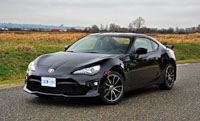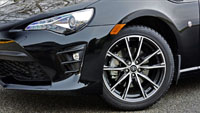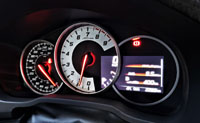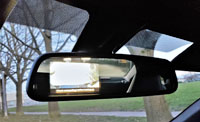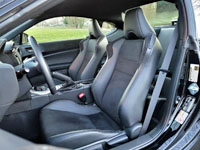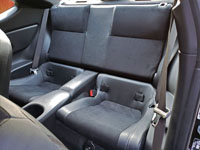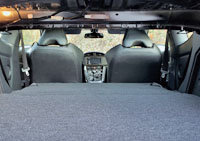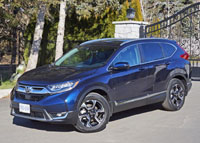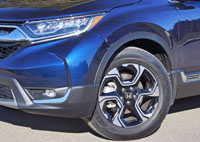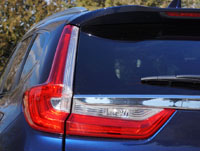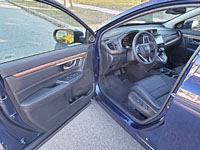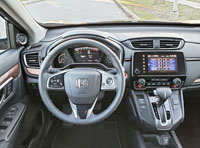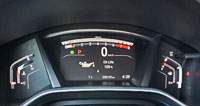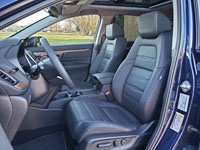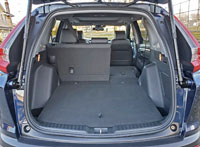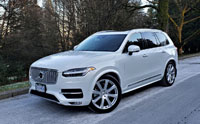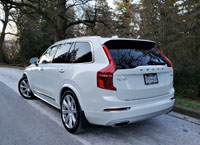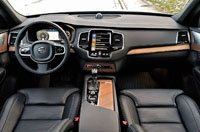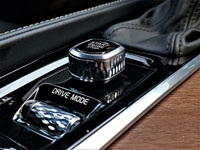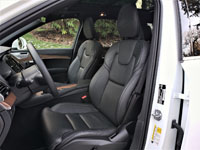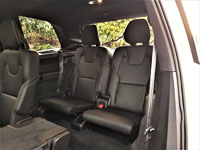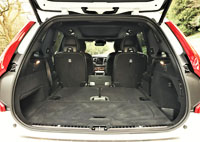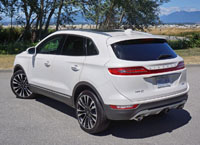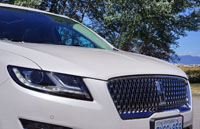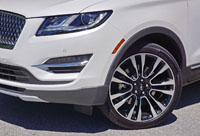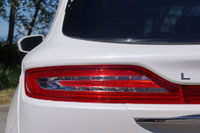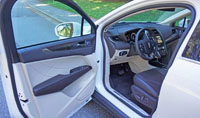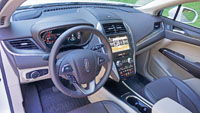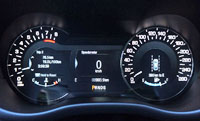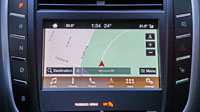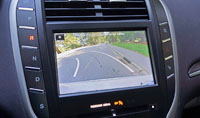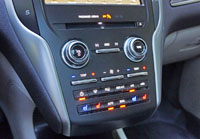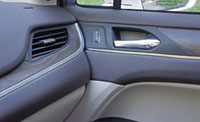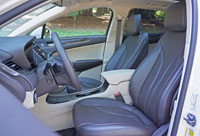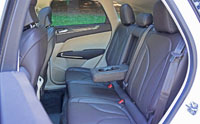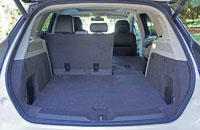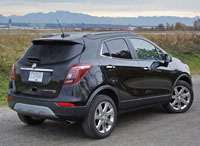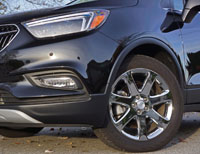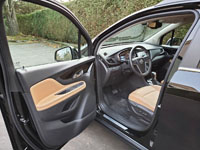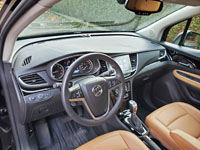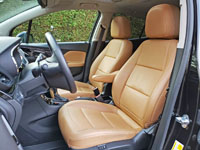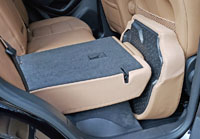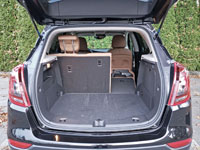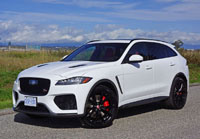
My gawd this thing is nuts! The power, the insane sound of the supercharged V8’s sport exhaust system, and the near overwhelming sensation of 550 horsepower and 502 lb-ft of torque pressing head and backside into the opulent red and black diamond-pattern leather-upholstered driver’s seat at launch while fingers grasp at the leather-wrapped sport steering wheel rim, there’s really nothing that completely mirrors it in the compact luxury SUV segment.
With a flagship sport utility like the F-Pace SVR you’d think this SUV would be tops in its hotly contested class, and while it’s certainly the best selling model within Jaguar’s range it appears luxury buyers are more interested in being comforted than having their senses wowed by ultimate performance. Truly, F-Pace and most Jaguar models deserve more attention than they get.
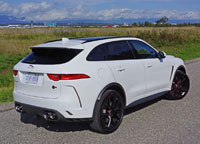
For starters, the F-Pace is inarguably attractive no matter which trim we’re talking about, with this SVR amongst the best looking in its category. There’s no crossover SUV I find more attractive, unless the outrageous Lamborghini Urus enters the discussion, or for that matter Audi’s Q8 that shares much of its running gear, but the ultimate Italian, at least, hovers up in a totally different pricing stratosphere with a base price of $240,569 CAD, compared to a mere $89,900 for this 2019 F-Pace SVR.
The cheapest Q8 will save you $7k and change, but the sporty looking German’s $82,350 entry model merely puts out 335 horsepower, and while a superbly comfortable and wholly attractive, well-made urban and freeway cruiser it’s doesn’t even enter the same performance league as the SVR. The equivalent Q8 is the upcoming near 600-hp RS, but that upcoming model will eventually cost you something around $110,000 (its pricing hadn’t been announced before I wrote these words, and it’s bigger mid-size proportions means it doesn’t directly compete).
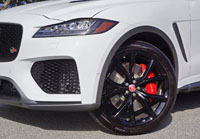
Targeted rivals in mind, Audi does offer up the 349-hp SQ5 in the F-Pace’s compact luxury SUV segment, and while a fully capable autobahn stormer, its 5.4-second sprint from zero to 100 km/h can’t line up against the SVR’s 4.3 seconds, and I can attest that its 3.0-litre turbo V6 doesn’t come close to sounding as Mephistophelian as the SVR’s supercharged 5.0-litre V8.
A truer F-Pace SVR competitor is the new Mercedes-AMG GLC 63 4Matic+ that makes 503 horsepower and 516 lb-ft of torque from a 4.0-litre twin-turbocharged V8 resulting in a blast from standstill to 100km/h in only 3.8 seconds. The Merc tops out at 280 km/h (174 mph) compared to the Jag’s slightly quicker 283 km/h (176 mph) terminal velocity, so they nearly share their two key bragging rights evenly. All you need do if you desire the Mercedes is to add about five percent or $4k onto your purchase, the AMG available just over $93k, unless you end up purchasing the 2020 F-Pace SVR that is, which is now $92k even.

Top-selling German compact luxury SUVs in mind, the BMW X3 M deserves mention too, thanks to 503 horsepower (in the Competition model), 442 lb-ft of torque, and a 4.1-second sprint from standstill to 100 km/h, all from an inline TwinPower turbo six-cylinder. The top-tier Competition model will set you back $93,500 plus fees, while the 473 horsepower base X3 M costs just $83,200.
See all pricing for the 2019 and 2020 F-Pace (or any of the SUVs mentioned) right here at CarCostCanada, including trims, packages and standalone options, while you can also access manufacturer rebate info, plus special deals including factory leasing and financing rates from zero percent (at the time of writing), as well as dealer invoice pricing that could save you thousands (there’s up to $3,075 in additional incentives on 2020 models right now) when becoming a member.
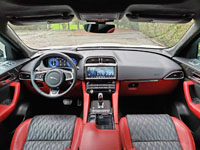
I haven’t driven the BMW X3 M or the GLC 63 4Matic+, but I’ve driven a lot of six-cylinder BMW Ms and AMG V8s, and while brilliant in their own rights, neither sounds as malevolent as Jaguar’s V8. Sure, the zero to 100km/h numbers are better and their prices aren’t much higher, but performance fans will know how important the auditory experience is to the thrill of high-speed driving. As for measuring the few milliseconds of sprint time differences, that’s downright impossible from the seat of the pants.
Using the Mercedes for comparison, both of these compact luxury SUVs provide nearly identical wheelbases of 2,874 millimetres for the SVR and 2,873 mm for the AMG, while their tracks are nearly the same too, the Jag measuring 1,641 mm up front and 1,654 mm in the rear and the Merc spanning 1,660 mm at both axles, but despite the F-Pace being 52 mm lengthier at 4,731 mm, 79 mm wider (mirrors included) at 2,175 mm, and 42 mm taller at 1,667 mm, plus having 100 litres of extra cargo capacity behind the back seats at 650 litres, it tips the scales 67 kilos lighter at just 1,995 kg. That’s thanks to its mostly aluminum body and chassis over Mercedes’ mix of steels and alloys.

I can’t move past this point without mentioning two more compact SUVs capable of contending in this ultra-fast compact luxury SUV category, these being the Porsche Macan Turbo and the Alfa Romeo Stelvio Quadrifoglio, the German making 400 or 440 horsepower depending on whether you’re looking at the outgoing 2019 model or the new second-generation 2020 variety, or for that matter choosing the older Macan with its Performance Package upgrade (which also puts out 440-hp). The more potent engine options make this German SUV’s acceleration similar to the F-Pace SVR, yet it’s pricing delves into six figures, while the zippy Italian produces 505 horsepower and sprints to 100 km/h in just 4.0 seconds, while its price starts at $95k. These two SUVs are impressive as well, but once again their turbocharged V6 engines, while brilliant, can’t measure up to the sonorous delights of Jaguar’s big, hairy V8.
Truly, you’ve got to hear it at full song to appreciate what I’m talking about. It’s giggle-inducing joy on one hand and devilish horror on the other, particularly after pressing the exhaust button that provides a freer flow resulting in more snap, crackle and pop from its backside when lifting off the gas pedal.

You’d think with this level of dark, malevolent behaviour its interior would be a hard stone dungeon of dank sombreness, and while some trim pulls thoughts of red hot hellfire, the SVR’s cabin gets raised the level of super SUVs from more exotic names. It’s also capable of loading in the kiddies and lots of family gear, thanks to that aforementioned cargo hauling capacity.
You can also experience some light off-roading, as long as you’re willing to change out my testers optional 22-inch black-painted rims and 265/40 front and 295/35 rear Pirelli Scorpion Zero all-season tires to something more useful off pavement. I’d recommend something around 18 inches in diameter with a higher sidewall and much more tread grip, but then again you’re probably not buying this SUV for scaling the Rubicon trail. No, it’s much more capable of turning winding side roads into straight stretches roadway, or at least its near flat stance at breathtaking speeds makes them feel as if they were straight.

The F-Pace SVR’s wide track and lighter than average weight (for its length, big powerplant and over-the-top luxury upgrades), plus the just-mentioned Pirelli rubber (you can get even better performance from a set of Jaguar-specified P Zeros, available from tire retailers) and its stiffer aluminum-intensive front strut and rear multi-link suspension featuring sportier tuning to its adaptive setup, plus sharper electric power-steering tuning, all come together for about as much sports car feel as most any SUV can provide (Urus aside).
The SVR shines on the types of narrow, undulating, ribbons of asphalt that the mind conjures up when looking at an F-Type SVR, but I have to say I really appreciated the added ride height this SUV provided over any low-slung sports car when coursing through heavily treed backroads. To be clear, the F-Type remains the Jaguar to beat through winding roads, not to mention road courses, but when visibility around curves or over sharp declines becomes difficult, the extra few inches of added sight line makes for a bit more confidence at high speeds, as does the wheel travel and more compliant suspension of the bigger, heavier SUV. Both SVRs work best when their previously noted Dynamic driving modes are selected, over their more comforting and economical options at least, this more assertive adaptive suspension setup stopping its tall body from pitching and rolling.
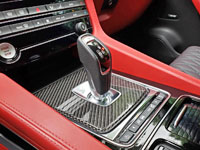
Of course, I didn’t drive it like I stole it during my entire weeklong test, and not just because of the otherworldly fuel cost. Transport Canada estimates a 14.5 L/100km city, with 11.0 highway and 12.7 combined, which not too bad considering its outrageous power. Alfa Romeo’s most formidable Stelvio is rated at 14.1, 10.4 and 12.4 respectively, while the new 2020 Macan Turbo manages 14.2 in the city, 10.1 on the highway and 12.0 combined. How about the Merc-AMG GLC 63? It’s pretty bad at 15.0 L/100km in the city, 10.9 on the highway and 13.2 combined, but BMW’s X3 M is the least fuel conscious amongst all rivals with an embarrassing rating of 16.6 city, 12.1 highway and 14.2 combined, if buyers in this class actually care.
Together with the SVR’s Dynamic sport mode mentioned before, which I kept engaged most of my test week, there’s also a Comfort mode for rougher road surfaces or more relaxing moods, plus an Eco mode, which I likely should have chosen more often for overcoming the fuel economy noted above. The latter two drive modes let the engine turn off when it would otherwise be idling, saving fuel and reducing emissions. The big Eco screen that estimated how much fuel I saved while using its most economical driving mode was a bit humourous in this beast of an SUV, but fortunately the centre display offers up a Performance panel too, which I found much more useful.
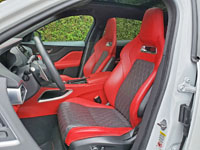
Unlike most in this class, the F-Pace only uses a touchscreen for accessing infotainment, which will put off those who prefer to make commands via a lower console-mounted controller. I like touchscreens so it’s not an issue, and even better Jaguar’s interface has wholly improved in recent years. The display itself is fairly big at just over 10 inches, while the digital interface is divided into three big tiles for navigation/route guidance/maps, media, and phone, or whatever functions you choose as it can be organized for personal preferences. Swipe the display to the left and a second panel with nine smaller tiles shows up, providing access to most any function you could want. It’s a simple, straightforward system and thus user-friendly, with its just-mentioned swipe gesture control accompanied by the usual smartphone/tablet-type tap and pinch capabilities, the latter helpful when using the nav system’s map. Android Auto and Apple CarPlay smartphone integration apps are included too, as are myriad additional features (although you’ll need to pay more for satellite radio), Jaguar’s system being fully up to the class standards.
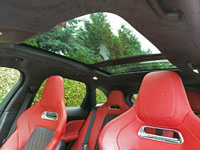
Better yet, the SVR’s 12.3-inch Interactive Driver Display (a.k.a. digital instrument cluster) is wonderful. It’s fully configurable, with the ability to appear like a classic two-dial primary gauge package, a single driving dial with a numeric speed readout surrounded by a graphical tach at centre with a panel filled with alternative info to each side, while you can also transform the entire cluster into a giant map. Go ahead an configure almost any way you want, while an available head-up display can provide even more key info right on the windshield.
There’s decent device connectivity within a minuscule centre bin, including dual USB-A ports, a Micro SD card slot, plus a 12-volt charger. Why Jaguar didn’t include a wireless charging as part of the rubberized pad ahead of the shifter that fit my Samsung S9 perfectly is anyone’s guess, but such is life. Oddly it’s not even available as an option for 2019 or 2020, so ask your dealer if there’s an aftermarket solution.
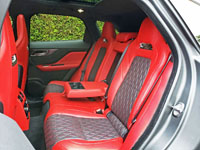
From the quality of electronics to the quality of the F-Pace SVR’s interior materials, not to mention interior quality and style of the five compact luxury SUVs discussed in this review, it’ll come down to personally taste, with all presenting fairly dramatic interior designs packed with better than average materials quality and worthwhile digital screen time. Having spent time with each of these vehicles in lesser trims for weeks apiece, I’d probably give the overall quality nod to Porsche quickly followed by BMW and Mercedes, with Jaguar SUVs seeming to have conceded the ultimate interior mantle to its Land Rover sister brand. The F-Pace is related to the Range Rover Velar, which provides a far more appealing cabin), whereas my Stelvio tester was the only vehicle in 20 years of reviewing cars that’s ever left its ultra-cheap hood release lever in my hand after trying to take a look at the engine (which I unfortunately never saw or photographed due to this bizarre malfunction).

The SVR does up the quality of its cabin materials plus its overall sense of occasion when compared to lesser F-Pace trims, especially when the optional black Suedecloth roofliner and pillars get added. Contrast stitched premium leather can be found just about everywhere else, the bottom portion my test model’s dash and centre console, plus its armrests and seat bolsters finished in a rich Pimento red colour, while Ebony Lozenge hides covered most other surfaces, including the quilted leather seat inserts. It’s an eye-catching design, but I personally would want something less red. I loved the carbon-fibre detailing elsewhere, mind you (this being an upgrade over the standard textured Weave aluminum inlays), while plenty of piano black lacquer glitz things up further. Ditto for brushed aluminum trim, the SVR replete with genuine aluminum accents, my favourite bits being seat backrest cutouts front and back.
While some in the super-SUV class only provide space for four, the F-Pace SVR includes a middle seat in back, but I personally wouldn’t want to sit on top of it, as it’s little more than a padded bump between two wonderfully sculpted outboard seats. For those who need somewhere to strap in a smaller child, it could be a dealmaker, but bigger kids and adults alike will be snapping up the window seats first, which provide excellent support all-round. Rear passengers can also benefit from as-tested available quad-zone automatic climate control, featuring its own control panel on the backside of the front console. Included are switches for the rear outboard seats’ three-way heated and ventilated cushions.

Another dealmaker is the rear passenger/cargo configuration, featuring a 40/20/40-split down the seatbacks. This means you wont be forced to stick one child (or friend) on the centre hump when heading to the ski hill, which might end up in some heated arguments when factoring in those just-noted seat warmers. Jaguar also offers cargo wall levers for folding down those seats automatically, but you’ll need to pay a bit extra for them.
I know I’m sounding all practical in a review that should really be more about power and performance, but if you only wanted to go as fast as possible you’d probably be reading one of my F-Type SVR reviews. The F-Pace SVR is a best of all worlds alternative, with one of the best sounding engines currently being made. If you’re wishing our compact SUV looked and felt more like a supercar, Jaguar’s F-Pace SVR might be just the ticket.
Story and photo credits: Trevor Hofmann



